
The COVID-19 pandemic has seen a raft of telepresence robots pressed into healthcare service worldwide, mainly to lend medical staff and patients a means of reducing the touchpoints that risk passing on a coronavirus infection. Such robots allow remote medics to talk to patients, gives them a means of receiving online video calls, and delivers meals or drugs to their bedsides, as well as ferrying tissue and blood samples to labs.
Beyond such laudable applications in medical institutions and quarantine facilities, some other mobile robotic technologies that have been deployed to police the pandemic have raised hackles: they have either been alarming people with their creepy form factors, or hectoring them verbally, or both, in ways that roboticists are concerned might dent the future acceptance of social robots in the home and at work.
The chief hackle-raising incident in this regard came in early May, when the city-state of Singapore revealed that it planned to unleash a headless four-legged dog-like robot to police Covid-19 social distancing rules in one of the state's sprawling public parks. The idea was that "Spot," an industrial quadruped robot from Boston Dynamics, would be repurposed to lope around the park's paths and green areas while verbally urging walkers, runners, and joggers via recorded message to stay at least a meter apart from each other.
In online video, the robo-animal is seen scampering around the park in all directions, with people scattering before it. It went down badly: some commenters writing on news sites such as CNBC said they would take a hammer, baseball bat, or shotgun to such a robot if it ever scurried across their paths. In the wider media, Elle magazine dubbed the quadruped droid terrifying and menacing, while The Late Show host Stephen Colbert likened it to Metalhead, the relentless, hunter-killer dog robot in one of the most terrifying episodes of the dystopian Netflix sci-fi series Black Mirror.
It wasn't only ground-based robots causing uncanny angst. In cities from Daytona Beach, FL to Hangzhou, China and Rabat, Morocco, local authorities have been mounting loudspeakers on aerial teleoperated robots (that is, multirotor drones of all sizes) and using them to target people in the street deemed, variously, not to be social distancing, not wearing face masks, or otherwise breaking lockdown rules/curfews, and hectoring them in the most patronizing of ways to obey from the skies.
It's not supposed to be this way. Over the last couple of decades, technologists and psychologists alike have been striving to work out how best to incorporate robots into society by ensuring they don't scare, harass, or endanger people, and instead work cooperatively with them to the most beneficial effect.
The field, known as human-robot interaction (HRI), is a recognized human factors discipline, one that has spawned its own peer-reviewed journals and conferences.
"I was surprised at the many new models of human-robot 'interaction' that have been unleashed on us in the Covid-19 crisis," says Tony Belpaeme, a professor of robotics and cognitive systems at Ghent University in Belgium. "Spot just upsets people as it trots through that Singapore park. It's a new machine, and not at all designed to look endearing. You can do dogs well; just look at Sony's long line of successful Aibo robot dogs. But this one just doesn't work."
In addition, Belpaeme says, "I also found the use of drones to shout at people disturbing. How did police departments think it would be a good idea to mount a speaker on a drone and fly up to people in parks to scold them? All empathy goes out of the window when delivering a message through a flying robot sounding like an angry wasp."
The Black Mirror connection may explain some of the fear people have of the Spot quadruped, says Belpaeme, but he says it could be anything from its spidery legs to its headless, utilitarian body, to the way it moves that is striking fear into those who say they would take weapons to it. "It looks very tense, agile, and fast, giving it a nervous appearance. What other unsuspected abilities does it have?" Of course, it also doesn't help that people are on edge due to Covid-19 fears, he adds.
At the University of Waterloo in Ontario, Kerstin Dautenhahn, the Canada 150 Research Chair in Intelligent Robotics, also has concerns over the way the COVID-19 pandemic has spawned applications of robots "such as monitoring and 'policing' of social distancing."
Says Dautenhahn, "A lot of HRI research over the past 20 years has studied how robots should interact with people in a socially acceptable manner, for instance, in how they should approach people, communicate and interact with them, and navigate in a socially aware manner in human-inhabited spaces. Such systems are, however, mostly still in development."
Due to the rush to deploy solutions in the pandemic, robots without the necessary social intelligence have had to be used, says Dautenhahn. "They have not been designed and developed specifically for social interaction, and so are often not sufficiently socially intelligent, in that they might not respect social spaces and conventions when approaching and communicating with people."
One HRI principle is that, in order to not startle people or frighten them, robots should approach people only from the front, and slowly. The Spot robot's teleoperator did not seem to be obeying any such guidelines in the Singapore park video; it seemed to stroll in multiple directions, and people seemed to scatter from it as a result.
By using robots not programmed with such social skills too soon, Dautenhahn thinks such deployments may "potentially damage the reputation of robots in general and only reinforce dystopian views of robots that "have been repeated in movies and sci-fi literature for many years."
For its part, Boston Dynamics says it had no intention of foisting on the public its dog-like, industrial quadruped technology, which it still sees as a technology best geared for working in dull, dirty, dangerous environments like power plants and oil refineries. Rather, it was the sheer urgency of the pandemic that demanded robots such as Spot be tried in multiple roles, says Michael Perry, the firm's vice-president of business development.
The public park deployment, Perry says, was a corollary of having its Spot robot working successfully as a telemedicine robot at an improvised outdoor quarantine center in Singapore; the authorities were so impressed with its ability to cope with non-uniform surfaces that local government asked to use the robot in the park, too. One major reason? "A few weeks earlier, one of the social distancing ambassadors working in the park had been stabbed" by someone who would not comply with the rules, Perry says, which is why robots that could offer distancing advice were sought out.
Was Boston Dynamics surprised at the Spot backlash? "There is a saying in robotics that everything is a robot until it becomes your dishwasher, meaning that it seems new and exciting until it does a boring and repeatable task," says Perry.
Because the Spot robot is far from an everyday sight, Perry says it was not much of a surprise that the deployment aroused some controversy. "It has a new morphology that people are primarily aware of through Terminator and Black Mirror, and so it is easy for them to extrapolate things about what the technology is, or what it's capable of doing, that really don't align with our intentions or, indeed, the technological capabilities of Boston Dynamics or any company at this point."
The challenge now, Perry says, is to inform people what the robot is really good at: applications where robot mobility is difficult. In other words, once people understand the utility of the legged droid for covering difficult terrain that wheels and tracks cannot handle, they won't fear it so much, if at all.
Other Covid-19 applications for the robot are aimed at metro stations and sports stadia, where Spot can spray disinfectant fluids from its robot arms and use a UV antiviral light source, after hours and out of sight of humans.
Boston Dynamics also has been working with Brigham and Women's Hospital in Boston, working out how Spot could help deliver telemedicine services in the improvised, outdoor tent-based triage facilities required by the high coronavirus patient volumes early in the pandemic. In that environment, Spot's legged mobility won out over wheeled medical robots that could not cope with bumpy outdoor surfaces. Inside flat-floored hospitals, however, this remains a job for wheeled robots, says Perry.
Given the risk of further waves of COVID-19 infection, Perry accepts that more public-facing applications for Spot may become necessary and, as a result, Boston Dynamics may need to address human-robot interaction design further. Says Perry, "One of the things that we've learned on the HRI side is that the robot might need to 'breathe'. Robots stay stock still when they are in a loiter state, and the only things in nature that stand stock-still are things that are about to pounce on you. An observation from one of our partners is that the robot needs to 'breathe' physically; that is, lightly bounce or shift its weight as it stands there, so it would seem less threatening."
Whether that will alleviate adverse reactions remains to be seen. Yet the Covid-19 crisis likely will fuel new avenues of HRI research, says Belpaeme, such as looking into what animal-based robot form-factors would best engender trust in robots that attempt to change human behaviors. "Research on just what it is that gives robots authority is needed. We've been working a lot on trust, the gentle side of authority. We know how a robot can persuade, but not how a robot can coerce people into taking or not taking action," he says.
That would help provide some of the social intelligence Dautenhahn thinks was missing in some robot deployments early in the pandemic. "I hope people will not start rejecting robots based on the repurposing of non-social robots in society during Covid-19," says Dautenhahn.
"Robotics is hard. Social robotics is even harder."
Paul Marks is a technology journalist, writer, and editor based in London, U.K.




Join the Discussion (0)
Become a Member or Sign In to Post a Comment